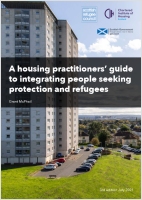Refugee status, humanitarian protection and discretionary leave to remain - what do they mean?
Who is a refugee?
In everyday use and in the media the word 'refugee' is often used to refer to people escaping from danger such as natural disaster, famine, political violence, or armed conflict. This is fine in everyday use but in many of these cases a person would not necessarily meet the legal definition of refugee. The legal definition is in the United Nations 1951 Refugee Convention:
'[is] someone who is unable or unwilling to return to their country of origin owing to a well-founded fear of being persecuted for reasons of race, religion, nationality, membership of a particular social group, or political opinion.'
A person who is found to meet these strict criteria who has claimed asylum in the UK or who has arrived through the UK Resettlement Scheme is granted refugee status. A person with refugee status is granted ‘refugee permission to stay’, ‘temporary refugee permission to stay’ or if their claim for asylum was made before 28 June 2022, ‘refugee leave’ (Immigration Rules, paras 334, 339QA). These are all forms of leave.
If a person's claim for asylum (refugee status) is refused but there are substantial grounds for believing that s/he would face a real risk of serious harm if returned to their country of origin, s/he may be granted humanitarian protection or temporary humanitarian protection. Both kinds of humanitarian protection are forms of leave under the immigration rules (Immigration Rules, para 339C, 339QB).
Refugee permission to stay, temporary refugee permission to stay, refugee leave, humanitarian protection and temporary humanitarian protection are all forms of protection status. The family members of a person with protection status can apply for family reunion leave.
A person who has claimed asylum but who does not meet the criteria for refugee status or humanitarian protection may be granted discretionary leave if there are other humanitarian reasons why s/he should be allowed to stay. Discretionary leave is granted outside the immigration rules and is only given in limited circumstances (such as to an unaccompanied person aged under 18).
A person who is a refugee (in its ordinary or legal sense) may also be granted leave with access to housing and benefits under one of the following special programmes:
- From 6 July 2018, a child, and any other child s/he is responsible for, who is a stranded unaccompanied child in Europe (a 'Dubs child').
- From 5 November 2018, a person who was transferred to the UK between 17 October 2016 and 13 July 2017 from the camps cleared around Calais so that s/he could be reunited with their family.
- From 16 September 2021, a person who has been granted leave under the Afghan Relocations and Assistance Policy (ARAP) (as former support staff to the UK armed forces) or who has been granted leave with access to public funds under the Afghan Citizens Resettlement Scheme (ACRS).
- From 22 March 2022, a person who was resident in Ukraine before 1 January 2022, left due to the Russian invasion and who has been granted leave under the Immigration Rules Appendix Ukraine Scheme, which includes the Ukraine family scheme and the Ukraine sponsorship scheme.
- From 15 May 2023, a person who was residing in Sudan before 15 April 2023 who left due to the escalating violence and has been granted leave without a sponsor and with access to public funds
- From 27 October 2023, a person who was residing in Israel, Palestine, Lebanon or the occupied territories immediately before 7 October 2023 who left in connection with the Hamas terror attack or the violence that followed and who has been granted leave without a sponsor and with access to public funds.
Most of these types of leave are time-limited and must be renewed. After you have served five, six or ten years' continuous leave you will be granted 'indefinite leave to remain' (ILR), in other words leave without time limit, also known as 'settled status'.
A person who is granted refugee status keeps it when s/he gets indefinite leave to remain. But refugee status is lost (but not ILR if s/he has it) if s/he returns to their home country or if s/he becomes a British Citizen.
A person who applies for leave to remain to be extended or changed to indefinite leave, remains covered by their existing leave until their application is decided, as long s/he applied before that leave expired. This can take a long time.
What is the UK Resettlement Scheme?
The UK Resettlement Scheme (UKRS) sometimes referred to as the ‘global resettlement scheme’ is the government programme to resettle people who have been identified as refugees by the United Nations High Commissioner for Refugees UNHCR. As with previous schemes (such as the Gateway Protection Programme), the aim was to prioritise the most vulnerable refugees but with a broader geographical coverage.
The scheme was due to be launched in April 2020, but was postponed due to Covid-19. Prior to its launch the aim was to resettle around 5,000 refugees in its first year of operation with decisions on the number of refugees to be resettled in subsequent years to be determined through future spending rounds. Responsibility for resettlement (including re-housing) is with local authorities, who submit their offer for places and for funding to the Home Office.
The UKRS comprises of:
- the Community Sponsorship Scheme, which enables community groups to directly welcome and support a resettled family into their local community, and
- the Mandate Resettlement Scheme which resettles refugees with a close family member in the UK who is willing to accommodate them.
For more information see the Home Office Policy Guidance (2021) (pdf).


